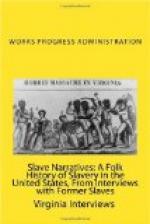“We would sing and pray Easter Sunday and on Easter Monday we frolicked and danced all day long! Christmas we allus had plenty good sumpin’ to eat and we all got togedder and had lots of fun. We runned up to the big ‘ouse early Christmas mornin’ and holler out: ‘Mornin’, Christmas Gif’!’ Then they’d give us plenty of Sandy Claus and we would go back to our cabins to have fun twel New Year’s day. We knowed Christmas was over and gone when New Year’s day come, kazen we got back to wuk that day atter frolickin’ all Christmas week.
“We didn’ know nuttin’ ’bout games to play. We played with the white folkses chilluns and watched atter ’em but most of the time we played in the crick what runned through the pastur’. Nigger chilluns was allus skeered to go in the woods atter dark. Folkses done told us Raw-Head-and-Bloody Bones lived in the woods and git little chilluns and eat ’em up effen they got out in the woods atter dark!
“‘Rockabye baby in the tree trops’ was the onliest song I heard my maw sing to git her babies to sleep. Slave folkses sung most all the time but we didn’ think of what we sang much. We jus’ got happy and started singin’. Sometimes we ’ud sing effen we felt sad and lowdown, but soon as we could, we ’ud go off whar we could go to sleep and forgit all ’bout trouble!” James nodded his gray head with a wise look in his bright eyes. “When you hear a nigger singin’ sad songs hit’s jus’ kazen he can’t stop what he is doin’ long enough to go to sleep!”
The laughter that greeted this sally brought an answering grin to the wrinkled old face. Asked about marriage customs, James said:
“Folkses didn’ make no big to-do over weddings like they do now. When slaves got married they jus’ laid down the broom on the floor and the couple jined hands and jumped back-uds over the broomstick. I done seed ’em married that way many a time. Sometimes my marster would fetch Mistess down to the slave quarters to see a weddin’. Effen the slaves gittin’ married was house servants, sometimes they married on the back porch or in the back yard at the big ’ouse but plantation niggers what was field hands married in they own cabins. The bride and groom jus’ wore plain clothes kazen they didn’ have no more.
“When the young marsters and mistesses at the big houses got married they ’lowed the slaves to gadder on the porch and peep through the windows at the weddin’. Mos’en generally they ’ud give the young couple a slave or two to take with them to they new home. My marster’s chilluns was too young to git married befo’ the war was over. They was seven of them chilluns; four of ’em was gals.
“What sort of tales did they tell ’mongs’t the slaves ’bout the Norf befo’ the war? To tell the troof, they didn’t talk much like they does now ’bout them sort of things. None of our niggers ever runned away and we didn’ know nuthin’ ’bout no Norf twel long atter freedom come. We visited round each other’s cabins at night. I did hear tell ’bout the patterollers. Folkses said effen they cotched niggers out at night they ’ud give ’em ‘what Paddy give the drum’.




